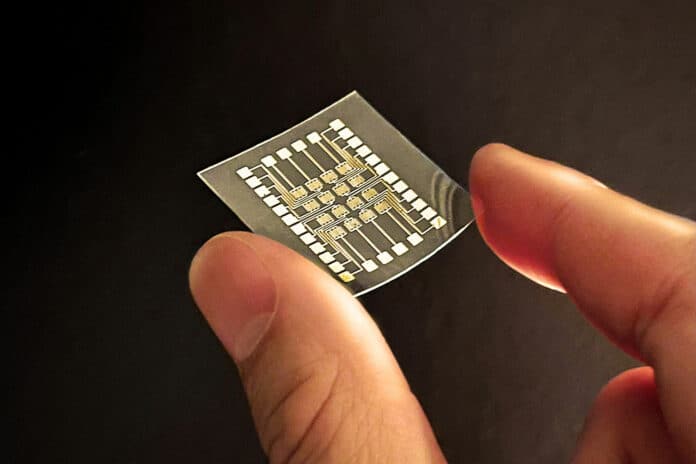Thin-film electronics pliably laminated on human skin for noninvasive, specific, and multifunctional sensing are ideal wearable systems for health monitoring and information technologies. However, it remains a critical challenge to fabricate ultrathin and compliant skin-like sensors with high imperceptibility and sensitivities.
Now, King Abdullah University of Science and Technology (KAUST) materials scientists have developed a wearable electronic that is so thin and flexible that it can be worn on human skin as a biosensor. This soft e-skin can detect the minute temperature difference between an inhaled and an exhaled breath. The ultrathin material is also sensitive to touch and body motion, suggesting a wide array of potential applications.
“The skin plays a vital role in our interactions with the world,” says Vincent Tung from KAUST, who led the work. “Recreating its properties in an e-skin could have profound implications for wearable electronics, as well as for sensory prosthetics, soft robotics, and human-machine interfaces.”
Despite considerable research effort, it has been very challenging to create suitable materials, which must be strong and highly sensitive yet imperceptible when applied to the skin.
In their research, Tung and his collaborators have shown a carbon nanomaterial called hydrogen-substituted graphdiyne (HsGDY) could be ideal for the task. This two-dimensional sheet of carbon atoms has similarities to graphene in its strength and electrical conductivity but also has key differences. Graphene’s tight honeycomb-like carbon structure lends material rigidity. On the other hand, HsGDY’s island-bridge atomic structure of rigid regions connected by thin polymer bridges, in theory, should provide an inherent softness and flexibility that is ideal for on-skin applications.
“The implementation of HsGDY into e-skin has long been touted by theorists but had yet to be demonstrated experimentally,” Tung says. The team first developed a novel synthetic strategy to form large uniform HsGDY sheets. “The key was our use of an atomically structured, single-crystal copper catalyst to couple the molecular building blocks of the material,” Tung explains.
The resulting material was highly twistable, stretchable, and mechanically durable. “At around 18 nanometers thick, our e-skin is a fraction of the thickness of human skin, enabling conformal contact and long-term adhesion to the body with maximum flexibility and comfort,” Tung says.
The nanomaterial’s island-bridge atomic structure not only contributes to HsGDY’s soft and flexible nature but is also key to its electronic properties. The bridges form ultrathin conduction channels that are easily deformed, resulting in significant changes in electrical signal when the material is stretched by a gentle touch or even by a temperature change. “The excellent sensitivity and conformability make it possible to visualize the tiny deformation caused by the temperature difference between inhalation and exhalation, showing promising potential for practical clinical applications,” Tung says.
Journal reference:
- Yichen Cai, Jie Shen, Jui-Han Fu, Nadeem Qaiser, Cailing Chen, Chien-Chih Tseng, Mariam Hakami, Zheng Yang, Hung-Ju Yen, Xiaochen Dong, Lain-Jong Li, Yu Han, and Vincent Tung. Graphdiyne-Based Nanofilms for Compliant On-Skin Sensing. ACS Nano. DOI: 10.1021/acsnano.2c06169
